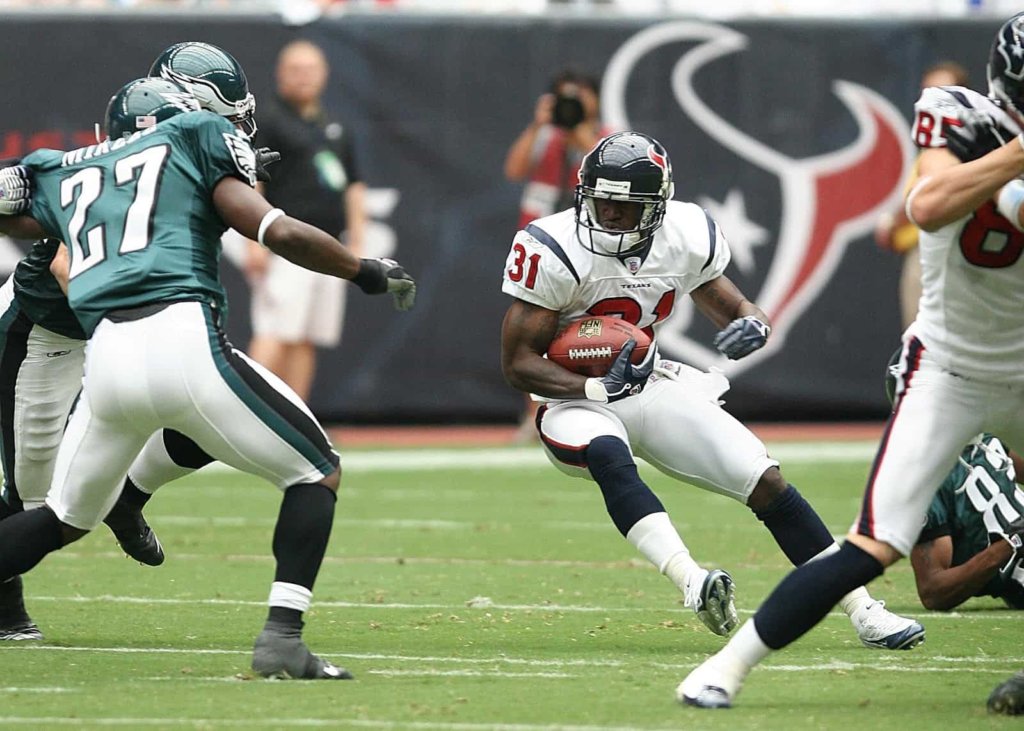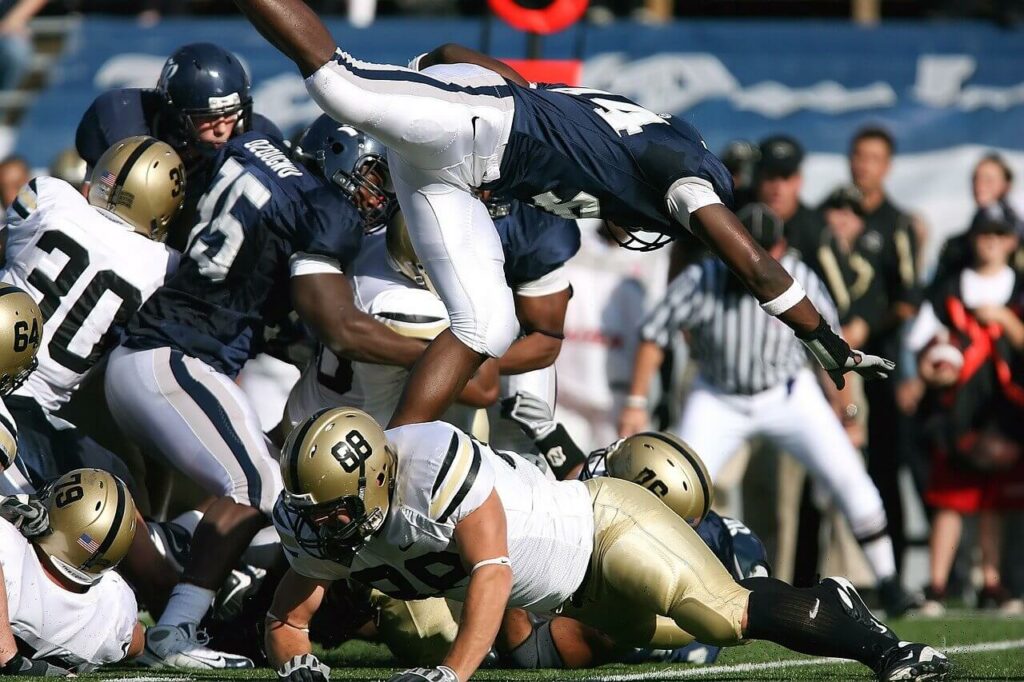How to Attack the 33 Stack

The stack defense is one of the most frustrating schemes to deal with, especially if you don’t see it very often.
10 years ago it was the en vogue defense…everyone was running it as an answer to defeat the spread offenses. But now it has fallen wayside to the 4-2-5….but almost every high school coach will see it at least once on their schedule.
The 3-3 defense can give you what seems like a different look on each play, leaving your offensive line waiting and reacting instead of firing off the ball.
Every defense has weaknesses. A good football coach knows the weaknesses of each defensive play call, and how to adjust to stop it. But before I talk to you about the weaknesses, let’s look at areas of concern:
- NOSE GUARD: Odd fronts typically put their most dominant player at Nose to handle double teams or will put a quick player there who is slanting and moving on every snap.
- BLITZING: There are 5 Linebackers who can blitz on every play, so blitz pickup rules must be easy to learn concepts that apply to multiple plays.
- PROTECTED MIKE LB: it’s difficult to get the play side guard to climb to him. If the nose slants to the play side, chances are your guard will get picked.
- Up to 8 Defenders in Tackle Box: You have to ensure that you are not outnumbered by one player.
So, understanding the strengths of the stack, the basic premise of attacking this defense is this:
- Formation them out of the stack. Force them to move/slide players out of their normal alignments.
- Attack the outside flanks and off tackle.
- Once they shift, slide, or adjust, then come up inside
SUGAR HUDDLE
Before I get into all of our un-balanced formations, I must tell you that they work for us because we sugar huddle 4 yards from the ball and sprint to the LOS. Our goal is to snap the ball 3 seconds after breaking the huddle. So it is very hard for the defense to recognize and adjust to all the unbalanced formations that I have listed below.
UNBALANCED
Many eight-man fronts can have issues adjusting to unbalanced formations. As my good friend Roger Holmes always says: run unbalanced formations at balanced defenses.
Keep in mind, the last thing a 3-3-5 stack team wants to do is “break the stack.” This eliminates their element of confusion.
Let’s start with how we attack off-tackle. One of the problems we used to face was the Mike LB shooting the B-gap everytime the playside Guard pulled on Buck and Down. (Fig 1) We solved that with our “Tee” call, which is made on all plays ran to the 6-hole vs odd fronts. This allows the Right Guard to pickup that blitzer. (Fig 2 & 3)
We also like the Tee call when they slide the NG to the strongside A-gap….and if the Mike LB is still shooting thru the B-gap, then we run our G-Lead play, or Power, (Fig 4).
We also dabble in the triple option game. We use our “ABC” blocking rules to run Midline, Inside Veer, and Outside Veer using only one blocking scheme. Versus the 33 Stack, we like to run CAL, or outside Veer.
Some other un-balanced formations we like are listed below:
Now I will let your imagination, go crazy, but we do NOT add any plays. We just run Jet, Buck, & Down out of these formations until they get out of their stack.
Two years ago we had a QB who was tremendous athlete. He ran for 2,100 yards and is playing at Dartmouth now, so we added our DELTA package, which is three variations of Power: Power Read, Power Wrap, and Power Lead
BLITZ PICKUP
We do not teach our linemen their blocking rules based on the play, rather everything is based on the hole. So we will attack the 6-hole many different ways (Buck, Down, Veer, Power)…but our linemen just follow their “6-hole” rules:
- Wing, TE, & Tackle are on railroad tracks. Whomever gets on their railroad tracks is road kill. Trains don’t turn and we don’t chase cowards. In other words, if a LB or DL loops, twists, or scrapes, we don’t chase them because now they are on somebody else’s railroad tracks.
- We also teach the “Butt-Hole” rule. Your butt must point to the hole on any block, whether down, on, or pulling.
By teaching these basic concepts our linemen are not confused by the 5 Linebackers blitzing from all directions. See, we never tell our linemen “you have this player on this play”….rather we teach them what track or area they are blocking and they block whatever opposite color jersey shows up on that track or area.
“If your Grandma shows up on your tracks in the other teams jersey, you pancake her ass”
ADJUSTMENTS
While taking a look at the diagrams above, we can see that the defense is put in a “bind”. They have to adjust to the extra blocker.
In Fig 10, they brought both SPURS to the stronside, so now we are going to hit them on the weakside with Belly, Jet, Speed Option, and Buck.
In Fig 11, if they slide the D-Line, now they are like any other even front and plays like Guard & Tackle Trap are effective.
Once they start sliding their Linebackers, we like to hit them with counter and guard trap.
In conclusion, in terms of defensive adjustments, the 3-3-5 stack defense is stuck. The defense will have to break the stack and shade their defensive line and linebackers. Once they have landmarked themselves, you get them out of their comfort zone. Once a defense is out of their own comfort zone, you got them right where you want them!
But never forget this important point:
Don’t make it about them. Always stay focused on what you do. Don’t confuse your players by trying to outsmart the other guys.
We preach and preach to our guys that the only team that can beat us…..is us.
Not the refs. Not the other team. Not the coaches on the opposite sideline.
Not even a bad play call or a mistake by one player.
It happens way too often. The team that beats you, is you.
Self-scouting is a critical part of preparation for the coming week. Your practice plan is built around fixing the problems you had last week.
Instead, most coaches center their plans for next week around the next opponent. New installs. New adjustments.
You need to step back. Fix what went wrong. Stop beating yourself.
Too much new stuff only leads to new problems. New issues that will need correction next week.
Which never happens. Because next week, you want to install more new stuff.
Build your game preparation around you. Your players. Around getting better.
Sure, you can install a new formation or a new blitz. That’s OK. Nothing wrong with it, within reason.
But make it the focus. Self-scout, identify the problems, and spend this week focused on beating your biggest opponent.
You.




Responses